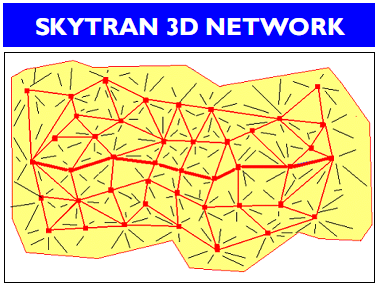However, big cities with well-established public transportation networks (including subway lines placed many decades ago) may be sufficiently well-served that they won't be early customers for SkyTran. Mass transit systems that would be impractical in the suburbs work very well in the city: there are hundreds of thousands or millions of people living in a relatively small area. Big cities like New York, Chicago, and Washington, DC have robust subway and bus systems that move people from one end of the city to the other. Yet even in cities with the best, most wide-ranging and convenient public systems, people often have problems getting to where they want to go when they want to go there. SkyTran's initial roles here may be as feeder systems that extend existing mass transit lines or serve areas where trains don't run frequently.
People who miss a bus or train may have to wait 15-20 minutes for the next one (depending on the day and time). People living in certain areas of the city often have spotty or nonexistent mass transit access. (On the far South side of Chicago, for example, which includes some economically disadvantaged areas, there are whole sections of the city which lack subway access and are covered by a patchwork of bus routes.) Even people in areas of the city with relatively good access to mass-transit often have to walk 15 or 20 minutes to get to their bus, subway, or light rail stop. People who live on a different bus or subway line than the one near their destinations have to transfer lines, sometimes multiple times, to get where they want to go.
All of these problems cause people stress and inconvenience, and take time and money away from them on a daily basis.
All of these problems are built into the structure of every traditional mass-transit system (subway, light rail, or bus), because they are centrally-run and centrally-planned and take passengers along predetermined routes to where the city planners (not the passengers themselves) want them to go.
None of these problems applies to SkyTran, because:
SkyTran is on-demand. It leaves when, and goes where, you want it to. You don't have to make stops for anyone but yourself. Going from one end of the city to the other becomes a 10-minute trip, instead of a 2-hour trip.
SkyTran is accessible. With stops every few blocks, people won't have to worry about walking very far to get where they want to go.
SkyTran is convenient. People don't have to worry about transferring between bus or subway lines, because a robust SkyTran network allows them to go from any one place to any other place in the city while staying in the same vehicle (just like with a car). Cities will finally be able to afford enough capacity to eliminate traffic congestion, even at rush hour.
In a megalopolis like Los Angeles, or Mexico City, or even Beijing, everyone will breathe easier without the pollution caused by millions of cars everyday.
Outside cities, SkyTran vehicles will go faster. At 150 MPH they'll still get over 100 MPG fuel economy, so inter-city travelers should find SkyTran faster than flying (counting airport delays) for trips of up to 500 miles. For longer trips, they can reach the airport or train station without parking or rental car delays. They'll even be able to make connections gate-to-gate between regional airports dozens of miles apart.
SkyTran is safe. Because there are several SkyTran pods waiting at each station and because those stations will be spread accessibly throughout the city, no one will have to wait to get in one, regardless of the neighborhood or the time of day. Also, because the SkyTran tracks are elevated, there won't be any danger of hitting pedestrians or waiting passengers the way buses, subway trains, and light rail trains do every year.
SkyTran doesn't take up space. In densely populated cities where space is at a premium, this last benefit is crucial. Space that could be used for housing or businesses is often taken up by subway stations or light rail lines. Whenever such systems are built or repaired, several blocks are cordoned off to make room for the construction. SkyTran stations, by contrast, resemble bus stations much more than they do subway stations: they are small, unobtrusive, and (in a pinch) portable.
And constructing SkyTran lines and stations is faster, easier, and cheaper than constructing other mass transit systems. The physical footprint of the whole SkyTran system is just a utility pole every 30 feet, plus stairs and elevators for station access. That's a tiny impact on city neighborhoods. Anyone who lives near a subway or light rail stop will appreciate the difference.


